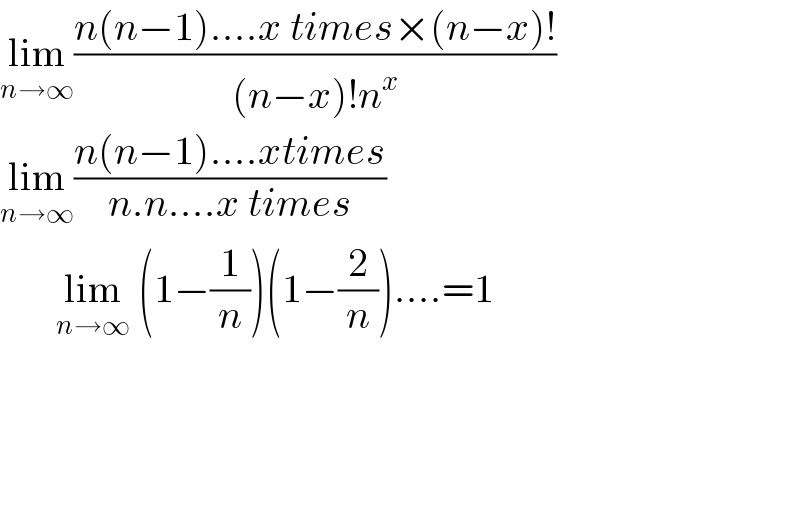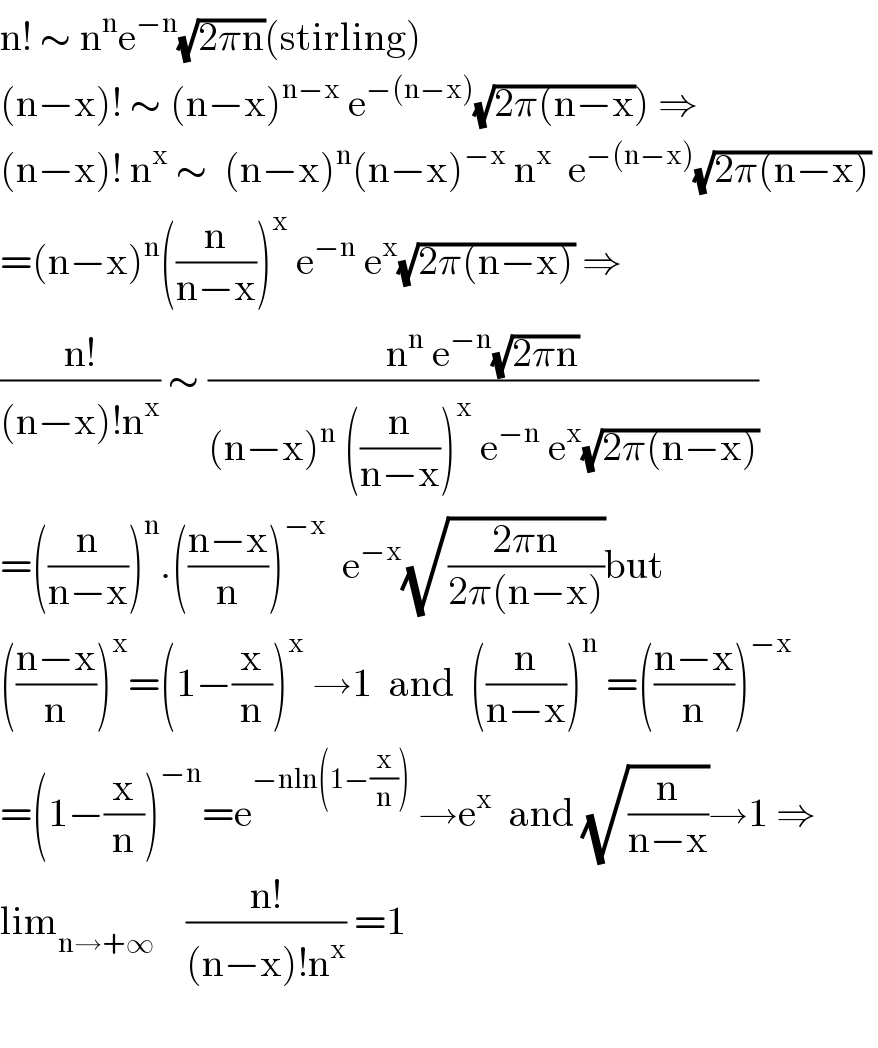
Question Number 106505 by Ar Brandon last updated on 05/Aug/20
![Show thatlim_(n→∞) [((n!)/((n−x)!n^x ))]=1](Q106505.png)
$$\mathrm{Show}\:\mathrm{that}\underset{\mathrm{n}\rightarrow\infty} {\mathrm{lim}}\left[\frac{\mathrm{n}!}{\left(\mathrm{n}−\mathrm{x}\right)!\mathrm{n}^{\mathrm{x}} }\right]=\mathrm{1} \\ $$
Answered by Dwaipayan Shikari last updated on 05/Aug/20

$$\underset{{n}\rightarrow\infty} {\mathrm{lim}}\frac{{n}\left({n}−\mathrm{1}\right)....{x}\:{times}×\left({n}−{x}\right)!}{\left({n}−{x}\right)!{n}^{{x}} } \\ $$$$\underset{{n}\rightarrow\infty} {\mathrm{lim}}\frac{{n}\left({n}−\mathrm{1}\right)....{xtimes}}{{n}.{n}....{x}\:{times}} \\ $$$$\:\:\:\:\:\:\:\underset{{n}\rightarrow\infty} {\mathrm{lim}}\:\left(\mathrm{1}−\frac{\mathrm{1}}{{n}}\right)\left(\mathrm{1}−\frac{\mathrm{2}}{{n}}\right)....=\mathrm{1} \\ $$$$ \\ $$$$ \\ $$$$ \\ $$
Commented by Ar Brandon last updated on 05/Aug/20
��Thanks. �� I arrived there while trying to demonstrate that as n and p go to infinity and zero respectively, the binomial probability distribution becomes approximately equal to the poisson distribution.
Commented by Dwaipayan Shikari last updated on 05/Aug/20
������
Commented by Dwaipayan Shikari last updated on 05/Aug/20
Are you from France?
Commented by Dwaipayan Shikari last updated on 05/Aug/20
Là nuit Bonne nuit
Commented by mathmax by abdo last updated on 06/Aug/20

$$\mathrm{here}\:\mathrm{x}\:\mathrm{is}\:\mathrm{real}\:\mathrm{not}\:\mathrm{integr}\:...! \\ $$
Commented by Ar Brandon last updated on 06/Aug/20
����Bonne Nuit, mon ami Shikari.��
Answered by mathmax by abdo last updated on 06/Aug/20

$$\mathrm{n}!\:\sim\:\mathrm{n}^{\mathrm{n}} \mathrm{e}^{−\mathrm{n}} \sqrt{\mathrm{2}\pi\mathrm{n}}\left(\mathrm{stirling}\right) \\ $$$$\left.\left(\mathrm{n}−\mathrm{x}\right)!\:\sim\:\left(\mathrm{n}−\mathrm{x}\right)^{\mathrm{n}−\mathrm{x}} \:\mathrm{e}^{−\left(\mathrm{n}−\mathrm{x}\right)} \sqrt{\mathrm{2}\pi\left(\mathrm{n}−\mathrm{x}\right.}\right)\:\Rightarrow \\ $$$$\left(\mathrm{n}−\mathrm{x}\right)!\:\mathrm{n}^{\mathrm{x}} \:\sim\:\:\left(\mathrm{n}−\mathrm{x}\right)^{\mathrm{n}} \left(\mathrm{n}−\mathrm{x}\right)^{−\mathrm{x}} \:\mathrm{n}^{\mathrm{x}} \:\:\mathrm{e}^{−\left(\mathrm{n}−\mathrm{x}\right)} \sqrt{\mathrm{2}\pi\left(\mathrm{n}−\mathrm{x}\right)}\: \\ $$$$=\left(\mathrm{n}−\mathrm{x}\right)^{\mathrm{n}} \left(\frac{\mathrm{n}}{\mathrm{n}−\mathrm{x}}\right)^{\mathrm{x}} \:\mathrm{e}^{−\mathrm{n}} \:\mathrm{e}^{\mathrm{x}} \sqrt{\mathrm{2}\pi\left(\mathrm{n}−\mathrm{x}\right)}\:\Rightarrow \\ $$$$\frac{\mathrm{n}!}{\left(\mathrm{n}−\mathrm{x}\right)!\mathrm{n}^{\mathrm{x}} }\:\sim\:\frac{\mathrm{n}^{\mathrm{n}} \:\mathrm{e}^{−\mathrm{n}} \sqrt{\mathrm{2}\pi\mathrm{n}}}{\left(\mathrm{n}−\mathrm{x}\right)^{\mathrm{n}} \:\left(\frac{\mathrm{n}}{\mathrm{n}−\mathrm{x}}\right)^{\mathrm{x}} \:\mathrm{e}^{−\mathrm{n}} \:\mathrm{e}^{\mathrm{x}} \sqrt{\mathrm{2}\pi\left(\mathrm{n}−\mathrm{x}\right)}} \\ $$$$=\left(\frac{\mathrm{n}}{\mathrm{n}−\mathrm{x}}\right)^{\mathrm{n}} .\left(\frac{\mathrm{n}−\mathrm{x}}{\mathrm{n}}\right)^{−\mathrm{x}} \:\:\mathrm{e}^{−\mathrm{x}} \sqrt{\frac{\mathrm{2}\pi\mathrm{n}}{\mathrm{2}\pi\left(\mathrm{n}−\mathrm{x}\right)}}\mathrm{but} \\ $$$$\left(\frac{\mathrm{n}−\mathrm{x}}{\mathrm{n}}\right)^{\mathrm{x}} =\left(\mathrm{1}−\frac{\mathrm{x}}{\mathrm{n}}\right)^{\mathrm{x}} \:\rightarrow\mathrm{1}\:\:\mathrm{and}\:\:\left(\frac{\mathrm{n}}{\mathrm{n}−\mathrm{x}}\right)^{\mathrm{n}} \:=\left(\frac{\mathrm{n}−\mathrm{x}}{\mathrm{n}}\right)^{−\mathrm{x}} \\ $$$$=\left(\mathrm{1}−\frac{\mathrm{x}}{\mathrm{n}}\right)^{−\mathrm{n}} =\mathrm{e}^{−\mathrm{nln}\left(\mathrm{1}−\frac{\mathrm{x}}{\mathrm{n}}\right)} \:\rightarrow\mathrm{e}^{\mathrm{x}} \:\:\mathrm{and}\:\sqrt{\frac{\mathrm{n}}{\mathrm{n}−\mathrm{x}}}\rightarrow\mathrm{1}\:\Rightarrow \\ $$$$\mathrm{lim}_{\mathrm{n}\rightarrow+\infty} \:\:\:\:\frac{\mathrm{n}!}{\left(\mathrm{n}−\mathrm{x}\right)!\mathrm{n}^{\mathrm{x}} }\:=\mathrm{1} \\ $$$$\:\:\:\:\:\: \\ $$
Commented by Ar Brandon last updated on 06/Aug/20
Thanks Sir. Sorry I didn't precise that. In my case x is a natural number. But still arrived at thesame result. Thanks��
Commented by Dwaipayan Shikari last updated on 06/Aug/20
Thanking you for your corrections
